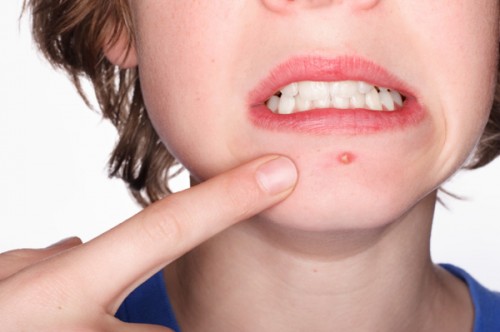Adolescent Acne – diagnosis and treatment methods
It is cruel irony that just at the time a child becomes overly concerned about self-image (teenage, adolescence) problems can develop with blemishes. More than 25% of visits to dermatologists for skin problems are for… pimples.
Even one blemish can take on overwhelming significance when it appears just before the big dance (by the way, stress is one of the triggers) especially on the face.
More than 100 million dollars are spent each year on over-the-counter pimple and acne treatment medications in the United States. Another 20 million dollars are spent on prescription acne medicines.

Teens are the time
for acne.
Although many teens see Dermatologists, it is estimated that approximately 3/4 of adolescents with acne can be adequately treated by their pediatrician.
Just why and how the lesions develop is still not fully known. Acne does tend to run in families, so there is a genetic aspect to its cause; it occurs at puberty with the secretion of androgens so hormones are another; and antibiotics sometimes help so bacteria is yet a third part.
Clogging of the oil and hair gland canal seems to be at the root of the problem. At puberty, sebum (waxy oil) production increases and dead skin cells clog the canal; which, then causes a “whitehead” to be developed.
The whitehead has been called the “true time bomb of acne.” Once it is formed the oil and skin cells continue to back up, increasing the pressure on the surrounding tissues until it ruptures, releasing the oils into the surrounding skin.
The whitehead has been called the “true time bomb of acne.
Then, the body’s own defense mechanism takes over rushing pus cells into the area in a typical inflammation response and forming what is called “papulo pustules.” These are what can lead to scarring.
“Blackheads” are different in that they do not usually lead to the development of papulo pustule lesions. They may be mistaken for dirt blocking the skin pores; but, the dark portion is just usually pigment.
Scrubbing the face vigorously or picking blackheads, unfortunately, may actually promote the formation of acne lesions (make them worse) by mechanically rupturing the canals and pushing the inflammatory matter directly into the surrounding skin.
Most of the cause of acne is beyond the control of the teenager; but, there ARE some things that make it worse. Scrubbing the face, pinching it, or rubbing it too much may cause even more pimples. Too much washing is not good nor is pinching or popping the pimples themselves.
Foods like chocolates, other sweets, french fries, and the like effect only rare individuals. If it makes you worse, then don’t eat it.
Foods like chocolates, other sweets, french fries, and the like effect only rare individuals. If it makes you worse, then don’t eat it.
Some makeup’s may actually block pores. Treatment has come a long way in the past few years. Most over-the-counter preparations contain Benzoyl Peroxide which seems to cut down facial bacteria, open up the pores, and decrease the amount of oil produced.
Two weeks of daily application of 10% Benzoyl peroxide has been shown to reduce oils by 50% and a certain type of acne producing bacteria by 98% (it takes four weeks of oral tetracycline to achieve the same effect).
However, Benzoyl peroxide does take four to six weeks before an appreciable benefit is noted. Benzoyl peroxide has a bit of a drying effect and will open pores. Unfortunately the outer layer peeling will often seem to make the teens acne worse for a few days before it gets better.
If redness or soreness of the skin develops, only use the product every other day for one to two weeks.
Retin-A (Tretinoin/retinoic acid) probably works by causing the pores to open up and slough off their extra dense cells faster. It is prescription, and therefore a little more expensive. If used too much or too concentrated it may cause irritation and peeling, but usually in about two weeks small little white heads come to the surface then resolve.
Antibiotics are occasionally helpful. Both tetracycline and erythromycin are usually well tolerated and have few side effects.
However, antibiotics can predispose the adolescent to yeast infections and tetracyclines should not be used in pregnancy because of their effects on the fetus.
Although these antibiotics should not be used as the sole form of therapy, they frequently do cause dramatic improvement.
Other forms of treatment like Accutane, topical antibiotics and injection of steroids are best used on only the very troublesome cases, and then probably only by a dermatologist.
Ultra-violet light and superficial x-ray therapy have dangerous long-term effects and should not be used. Medicated soaps, special cleansers, alcoholic wipes, and abrasive scrubs have no real proven beneficial effects.

